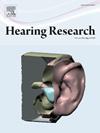C57BL/6-derived mice and the Cdh23ahl allele – Background matters
IF 2.5
2区 医学
Q1 AUDIOLOGY & SPEECH-LANGUAGE PATHOLOGY
引用次数: 0
Abstract
C57BL/6-derived mice are the most utilised mice in biomedical research, and yet actually there is no such thing as a generic C57BL/6 mouse. Instead, there are more than 150 C57BL/6-derived sub-strains recognised by the Mouse Genome Informatics (MGI) database, each of which carry sub-strain-specific fixed genetic differences that can potentially lead to phenotypic differences affecting a single, or multiple biological systems. One of the most widely known strain-specific alleles is the Cdh23ahl allele, a single nucleotide change that predisposes C57BL/6-derived mice to a progressive hearing loss that starts in the high-frequency region. As such, this allele is of particular relevance to auditory researchers. However, a recent study, comparing C57BL/6NTac mice with a co-isogenic strain in which the Cdh23ahl allele has been ‘repaired’ using genome editing, suggests that the Cdh23ahl allele may have a broader effect on phenotype expressivity of mouse mutants impacting not just the auditory system, but other organ systems as well. Here, using the Cdh23ahl allele as an exemplar, we discuss the importance of knowing, understanding and reporting the genetic background of mouse mutants.
C57BL/6来源小鼠和Cdh23ahl等位基因-背景问题
C57BL/6衍生小鼠是生物医学研究中使用最多的小鼠,但实际上并没有通用的C57BL/6小鼠。相反,有超过150个C57BL/6衍生的子菌株被小鼠基因组信息学(MGI)数据库识别,每个子菌株都携带子菌株特异性的固定遗传差异,这些遗传差异可能导致影响单个或多个生物系统的表型差异。最广为人知的一种菌株特异性等位基因是Cdh23ahl等位基因,这是一种单核苷酸变化,可使C57BL/6衍生的小鼠在高频区域开始出现进行性听力损失。因此,这个等位基因与听觉研究人员特别相关。然而,最近的一项研究将C57BL/6NTac小鼠与使用基因组编辑技术“修复”Cdh23ahl等位基因的共等基因菌株进行了比较,表明Cdh23ahl等位基因可能对小鼠突变体的表型表达具有更广泛的影响,不仅影响听觉系统,还影响其他器官系统。本文以Cdh23ahl等位基因为例,讨论了认识、理解和报道小鼠突变体遗传背景的重要性。
本文章由计算机程序翻译,如有差异,请以英文原文为准。
求助全文
约1分钟内获得全文
求助全文
来源期刊

Hearing Research
医学-耳鼻喉科学
CiteScore
5.30
自引率
14.30%
发文量
163
审稿时长
75 days
期刊介绍:
The aim of the journal is to provide a forum for papers concerned with basic peripheral and central auditory mechanisms. Emphasis is on experimental and clinical studies, but theoretical and methodological papers will also be considered. The journal publishes original research papers, review and mini- review articles, rapid communications, method/protocol and perspective articles.
Papers submitted should deal with auditory anatomy, physiology, psychophysics, imaging, modeling and behavioural studies in animals and humans, as well as hearing aids and cochlear implants. Papers dealing with the vestibular system are also considered for publication. Papers on comparative aspects of hearing and on effects of drugs and environmental contaminants on hearing function will also be considered. Clinical papers will be accepted when they contribute to the understanding of normal and pathological hearing functions.
 求助内容:
求助内容: 应助结果提醒方式:
应助结果提醒方式:


